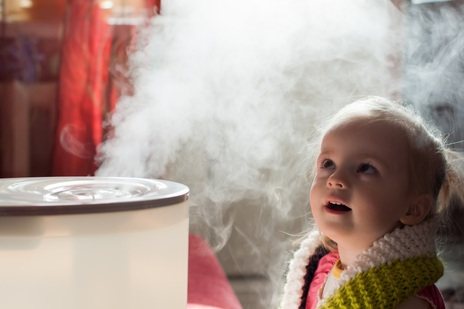
Humidity is the level of moisture in the air, and it can affect your comfort in your San Antonio home. The level of moisture in your indoor air is measured by the amount of water vapor in the air in relation to how cool it is. To maintain the right amount of moisture in your home, you need a humidifier or dehumidifier.
Humidifiers add moisture to your indoor air while dehumidifiers remove excess moisture in the air. Controlling the humidity in your home will help to improve your indoor air quality, comfort, and overall health. Here is how each one works.
Humidifiers
There are various types of humidifiers, and they are generally classified into two main types: warm-mist humidifiers, or steam vaporizers, and cool-mist humidifiers. They both have the same function of adding moisture into the air, and the main difference is how they do it.
Cool-Mist Humidifiers
These humidifiers work by breaking water into small particles that are released into your indoor air as water vapor. They also help to keep the air cool as the tiny water particles remain cold. There are three types of cool-mist humidifiers: ultrasonic, impeller, and evaporators.
Impeller Humidifiers
Impeller humidifiers use a ceramic plate or diaphragm that runs at high speeds and a diffuser that breaks up the water into tiny droplets. The droplets are released into your indoor air and float out as a cool fog. This type of humidifier is very affordable and carries no risk of burns, making it very child-friendly. The only downside is that it can only be used in a single room and can cause allergies when used for an extended period of time. It can also encourage the growth of mold as they release too much moisture into the air.
Ultrasonic Humidifiers
Ultrasonic humidifiers also use a disc immersed in water that vibrates at ultrasonic speeds to vaporize water, and they can produce a warm or cool mist. Their price may vary depending on the size you are buying for your home. The cool-mist versions are ideal if you have kids in the house.
Evaporators
Evaporators release moisture through a moistened filter or belt that moisturizes it. They are powered by a fan that blows over the wet object and allows the indoor air to absorb the moisture. The main advantage of this system is that it’s self-regulating. As the relative humidity rises, the humidifiers reduce the amount of water vapor released into the air.
Steam Humidifiers
Steam vaporizers are powered by electricity and boil water and release warm steam. They are not expensive since they use a simple mechanism to add moisture into the air. They can be used with essential oils and inhalants to help reduce coughs. However, they are not ideal if you have kids as they can cause burns. They can also cause high energy bills.
Central Humidifiers
Central humidifiers are installed into your HVAC system and are more expensive than portable humidifiers. They do not emit steam and are the best choice to add moisture throughout your whole house.
Ultrasonic and impeller dehumidifiers do not use a lot of energy, making them economical. If the water in the tank is stagnant, it can develop bacteria that can be released into your indoor air. It’s crucial that you refill the water in the tank regularly with clean water. Some ultrasonic versions have antibacterial features to make them safe for people with asthma or allergies.
Additionally, using mineral water in humidifiers can release the minerals into the air. They appear in the air as dust and can cause allergies. Look for humidifiers with demineralization cartridges to filter out minerals.
Humidity in your indoor air can be measured using a hygrometer. It shows the relative humidity of your home. Some humidifiers can track your home’s relative humidity and automatically turn off when the ideal humidity is reached. The comfortable relative humidity of a home is about 30% to 50%. High humidity can lead to the growth of harmful bacteria, mold, and mites. They can trigger asthma attacks or allergies.
Dehumidifiers
Dehumidifiers work to get rid of excess moisture in your indoor air. They use a fan to take in air that passes over metal coils that cool it down. The coils use a refrigerant with chemicals that reduce the temperature. As the warm air is cooled, it contracts, and the condensation is left inside the dehumidifier. The water is collected in a storage tank outside the dehumidifier. Cooled air is then released back into your indoor air through a fan-powered tube.
You can notice the presence of high humidity in your indoor air by checking for water stains on surfaces such as walls and ceilings. If your home has poor ventilation, you may experience high humidity. You may also experience a musty smell or notice tiny black spots on the walls.
If you notice these signs, you need to contact a trusted HVAC company like Beyer Air Conditioning & Heating to install quality dehumidifiers to improve your indoor air quality. We offer quality products to the residents of San Antonio, and our experienced technicians will ensure they install them properly.
Dehumidifiers can help to remove bad odors in humid environments. They also help prevent the growth of molds and improve your indoor air quality. There are two main types of dehumidifiers: desiccant and compressor humidifiers.
Compressor Dehumidifiers
Compressor dehumidifiers are the most popular and use condensation to remove moisture from the air. They draw warm air and pass it over a refrigeration coil where condensation happens. The warm air meets a cold surface, and water is removed from the air and channeled into a storage tank.
Compressor dehumidifiers work best in warm climates since they have to be colder than the air in the environment. They also help maintain the room temperature by reheating the air and releasing it. Compressor dehumidifiers are economical to run since they do not consume a lot of energy. On the other hand, they tend to produce a lot of noise and are very heavy.
Desiccant Dehumidifiers
Desiccant dehumidifiers consist of a compressor and cold surface that sucks the moisture from the air. They use a desiccant wheel to absorb water from the humid air. They usually have a compact design and do not produce a lot of noise. They are durable and portable and require little maintenance. Desiccant dehumidifiers are great for both warm and cold climates and can keep your home warm during the winter.
Humidifiers for Winter
The air is usually dry during the winter, and you can use a humidifier to add more moisture to your indoor air. Dry air can lead to allergies and trigger asthma attacks. It can also lead to other issues like:
- Nosebleeds
- Cold
- Sore throat
- Bronchitis
- Influenza
- Sinus inflammation
Using a humidifier during the winter can help you maintain your health and home comfort. It can also help to maintain your furniture and prevent your skin from dehydrating. Since the air is dry during the winter, it may not be appropriate to use a dehumidifier. However, you may need a dehumidifier in the winter for your basement since it has little exposure to sunlight and heat.
Beyer Air Conditioning & Heating offers quality air conditioning and heating services. We also provide indoor air quality, duct cleaning, and duct repair services. Our technicians are licensed and certified with years of experience. We operate within our core values of integrity, teamwork, respect, and honesty and guarantee 100% satisfaction. Contact Beyer Air Conditioning & Heating today for more information!



